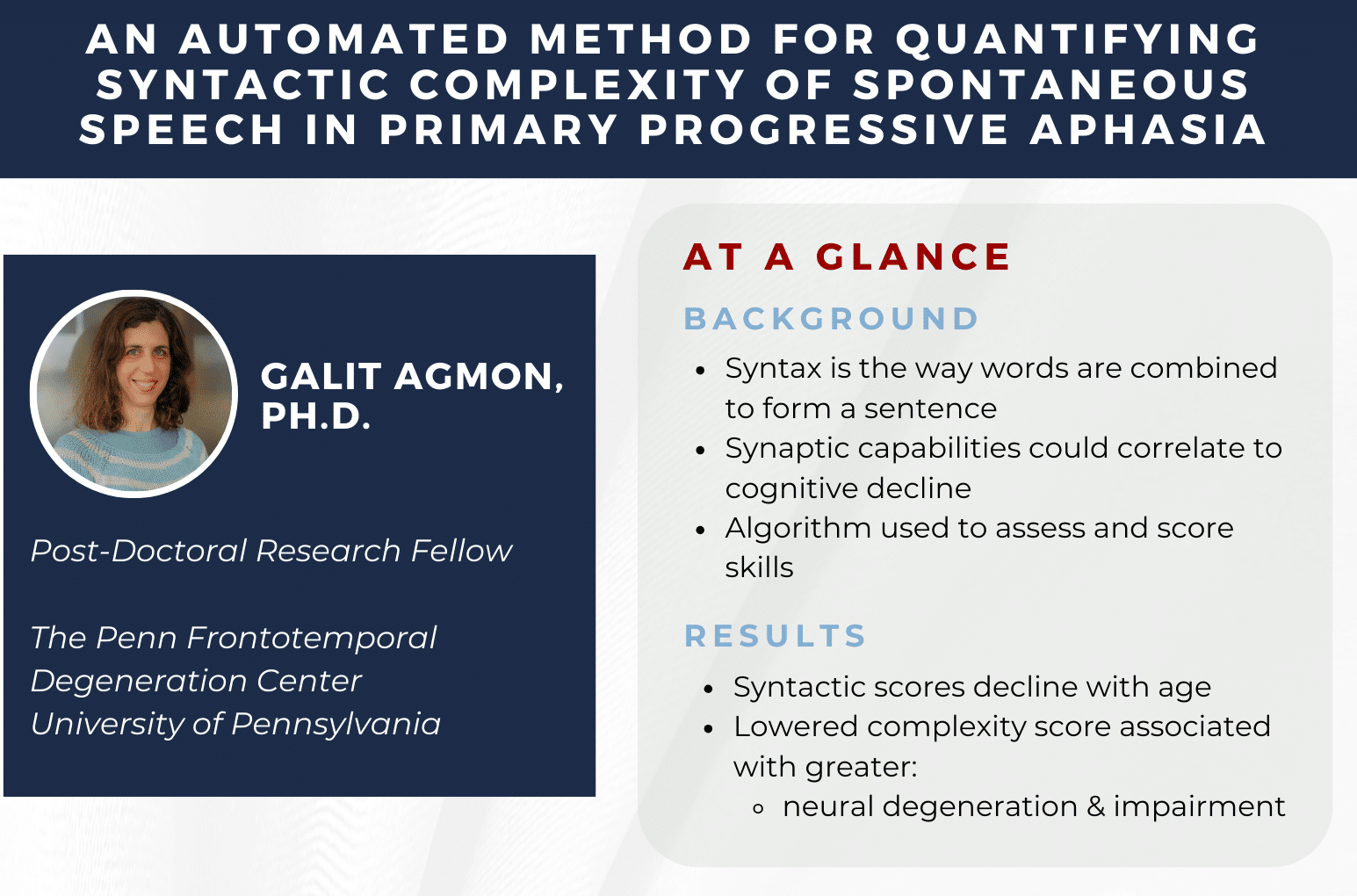Author’s Note: This article is part of our coverage of the 2024 Alzheimer’s Association International Conference (AAIC). To view all highlights, please click here.
At the 2024 Alzheimer’s Association’s International Conference (AAIC), hundreds of Alzheimer’s disease and related dementias (ADRDs) experts presented on innovative and diverse topics in the field. When reviewing poster presentations, the Penn Memory Center (PMC) Communication’s team noted that several researchers used speech analysis to measure cognitive decline.
An everyday function, speech can be a critical marker for cognition. For instance, the pace at which someone speaks, complexity of words used, and pauses within speech are all qualities that can be analyzed.
Among the many presentations, the work of Sanjana Skellikeri, PhD, and Galit Agmon, PhD, stood out for their innovative use of speech analysis to measure cognitive decline.
Both women described their work in short summaries for PMC community members.
Digital speech markers of cognitive impairment in ALS-FTD spectrum disorders
- Who: Sanjana Shellikeri, PhD, a postdoctoral researcher at the Penn Frontotemporal Degeneration Center
- Why: Our study explores how analyzing natural speech can help identify cognitive impairment in people with amyotrophic lateral sclerosis (ALS) and frontotemporal dementia (ALS-FTD). This condition has a worse prognosis than ALS alone. Traditional cognitive tests are time-consuming and require trained personnel. We investigated if a more objective method, such as analyzing speech patterns, could be effective.
- How: Participants described a picture of a kitchen scene, which took approximately one minute. We found that people with ALS-FTD spoke in shorter segments, took longer pauses, had less speaking time, spoke more slowly, used fewer adjectives, and had less diverse language compared to those with just ALS and healthy individuals. These speech characteristics allowed us to accurately distinguish between ALS-FTD and ALS.
- What: The speech timing patterns in ALS-FTD were linked to the severity of cognitive impairment. The language deficits were uniquely captured by the picture description task. Our findings suggest that a quick, one-minute picture description task could be a valuable screening tool for detecting cognitive issues in individuals with ALS-FTD.
- In future studies, we plan to investigate whether speech patterns in ALS patients with milder cognitive or behavioral impairments, without overt dementia, could serve as early markers for diagnosis and management.
An automated method for quantifying syntactic complexity of spontaneous speech in Primary Progressive Aphasia
- Who: Galit Agmon, PhD, a postdoctoral researcher at the Penn Frontotemporal Degeneration Center
- I am a neuro-linguist, trained in multidisciplinary programs in both theoretical linguistics and computational neuroscience. I am currently completing my postdoctoral training at the University of Pennsylvania, at the Frontotemporal Degeneration Center (FTDC), where I have been working on syntactic complexity in the speech of healthy people and people with aphasia.
- Why: Syntax, the systematic arrangement of words to form meaningful units, is fundamental to communication. Implicit knowledge of syntax can be specifically impaired in certain neurodegenerative conditions, making syntactic capability—and its decline—an important indicator of cognitive impairment. Currently, there is no simple way to assess this.
- How: In my work, I develop algorithms that extract syntactic features from naturalistic speech samples, language spoken in a real-world setting. I use them to quantify syntactic capacity. More broadly, as a neuro-linguist, I connect language performance to brain structure and function. To this end, I use linguistic theory, machine learning algorithms, and cognitive data analysis.
- What: More specifically, my algorithm analyzes a speech sample for its syntactic structure. The algorithm scores the syntactic complexity of the speaker’s speech. Along with my colleagues at the FTDC, we were able to show that this novel syntactic score declines at older ages. We also found that people with aphasia, in particular the non-fluent agrammatic variant (naPPA), show a substantial impairment in their syntactic ability. Finally, we demonstrated that syntactic complexity score can track disease progression, with complexity declining as impairment increases and neural degeneration advances.
To read about speech measurements being utilized to detect early-stage dementia, please click here.

